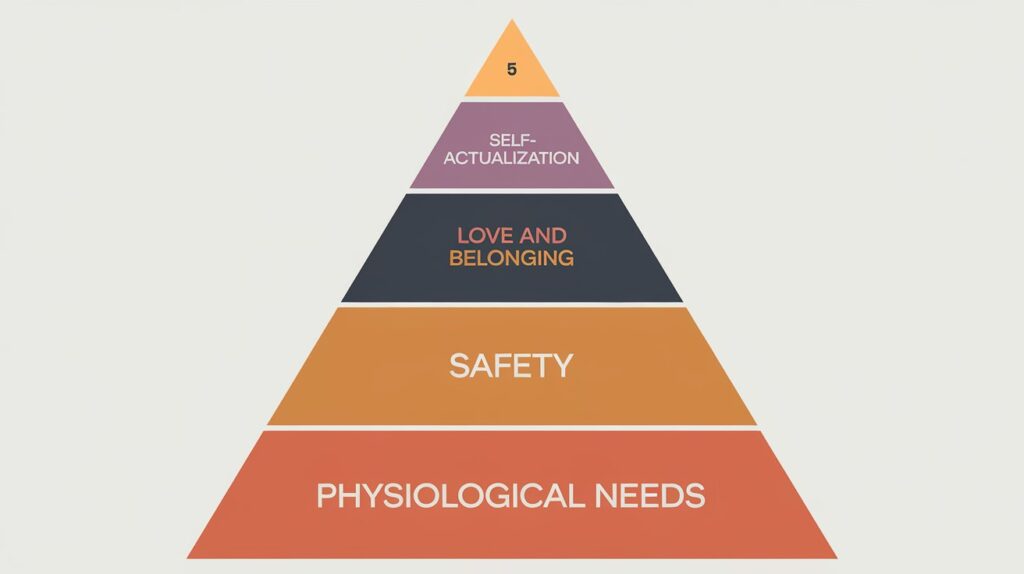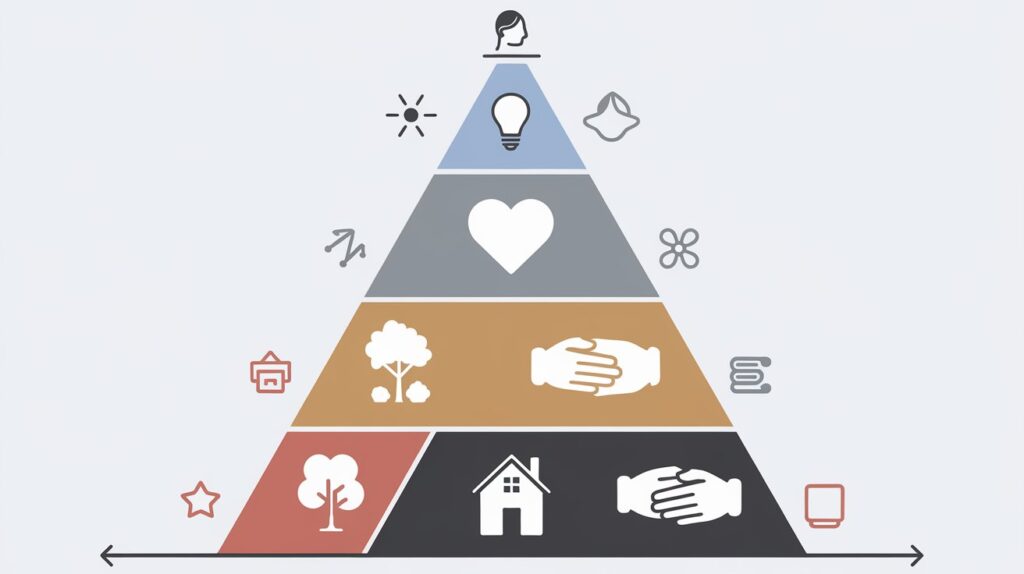The desire to fulfill specific, systematically organized needs is at the core of human behavior. American psychologist Abraham Maslow formalized this understanding through his model, Maslow’s Hierarchy of Needs. This framework organizes human needs into a pyramid, where basic needs must be satisfied before addressing higher-level psychological and self-fulfillment needs. This article will explore each stage of Maslow’s hierarchy of needs, from its foundational physiological requirements to the pinnacle of self-actualization.
The Five Levels of Maslow’s Hierarchy of Needs
1. Physiological Needs: The Foundation of Survival
At the base of Maslow’s hierarchy of needs, we find physiological needs to be the most essential requirements for human survival. These include food, water, air, sleep, and shelter. These are the first and most crucial needs that must be satisfied because the body cannot function without them. Imagine trying to focus on building relationships or achieving personal goals while you’re hungry or deprived of sleep. It’s nearly impossible, so these needs form the foundation of Maslow’s pyramid. They are non-negotiable for human survival, and until they are met, nothing else matters.
2. Safety Needs: Protection and Security
Once physiological needs are fulfilled, attention shifts to safety. Safety needs encompass both physical and emotional security. Humans crave a stable environment free from threats, which includes personal safety, financial security, health, and well-being. These needs are crucial because they ensure that individuals can live without fear or anxiety. For instance, a person who feels physically unsafe due to their living conditions will focus their energy on finding a secure place to live before they can invest in higher-level psychological or emotional goals. In Maslow’s hierarchy of needs, safety plays a significant role in creating a stable platform for personal growth.

3. Love and Belonging: Relationships and Connection
Humans are social creatures, and after their basic and safety needs are met, they naturally seek to form meaningful connections with others. The third level in Maslow’s hierarchy of needs centers around love and belonging. This need for relationships manifests in the desire for friendships, family bonds, and romantic connections. Humans thrive in environments where they feel they belong and are accepted. Social support systems, whether through close friendships or intimate relationships, provide emotional nourishment and a sense of community. Without satisfying this need, individuals may experience feelings of loneliness or isolation, which can hinder personal growth and development.
Also Read: Castor Oil Packs: A Natural Remedy with Timeless Benefits
4. Esteem Needs: Achievement and Respect
At the fourth level of Maslow’s hierarchy of needs, we encounter esteem needs, which revolve around self-worth, accomplishment, and recognition. Humans inherently desire to feel valued and respected by themselves and by others. There are two components to esteem: self-esteem (confidence, mastery, independence) and esteem from others (recognition, status, reputation). People strive for achievements that will make them feel competent and accomplished. Whether through career success, artistic endeavors, or other forms of achievement, meeting esteem needs provides individuals with a sense of accomplishment and purpose. A lack of recognition or failure to meet these needs can result in feelings of inferiority or self-doubt.
5. Self-Actualization: Fulfilling One’s Potential
At the top of Maslow’s hierarchy of needs lies self-actualization, the ultimate level where individuals strive to realize their fullest potential. Self-actualization is about personal growth, creativity, and the pursuit of inner purpose. It’s about becoming the best version of oneself, reaching goals, and embracing what truly drives you. People who achieve self-actualization are often motivated by a desire for personal development, self-expression, and a deeper understanding of their purpose in life. This could manifest through artistic pursuits, leadership roles, or humanitarian efforts. Self-actualization is unique to each individual, as it involves realizing one’s talents and dreams.
The Hierarchical Nature of the Pyramid
The key concept behind Maslow’s hierarchy of needs is that each level of need must be satisfied before moving to the next. For example, focusing on relationships, self-esteem, or self-actualization is challenging if someone’s physiological or safety needs are unmet. Maslow theorized that unmet needs lower on the pyramid prevent higher needs from being the primary focus. This hierarchical structure highlights the natural progression of human motivation—once basic needs are fulfilled, people seek higher psychological and personal growth levels.
However, it’s essential to understand that while the hierarchy is often depicted as a pyramid, it’s not strictly linear. In reality, individuals fluctuate between levels depending on life circumstances. For instance, during a crisis, a person might regress to focusing on safety and security even if they have previously achieved higher needs.

Criticisms and Modern Perspectives
Though Maslow’s hierarchy of needs is widely accepted and used in various fields such as psychology, education, and business, it has faced some criticisms. Critics argue that the model is too rigid, as only some individuals follow the same path of motivation. Cultures and individuals may prioritize needs differently, and some may seek self-actualization even when lower needs are unmet. Additionally, modern psychologists have expanded the hierarchy, adding more levels like cognitive and aesthetic needs, reflecting the complexity of human desires.
Despite these criticisms, Maslow’s hierarchy of needs remains a foundational theory in understanding human motivation and development. It offers a valuable framework for analyzing how individuals pursue satisfaction and fulfillment, and it provides insights into human behavior that are still relevant today.
Conclusion
In conclusion, Maslow’s hierarchy of needs offers an insightful model for understanding the progression of human motivation. From the most basic physiological needs to the fulfillment of self-actualization, the hierarchy provides a structured way to examine what drives people to achieve different levels of satisfaction and growth. While not every individual may follow the hierarchy strictly, step-by-steply, the model’s enduring relevance highlights the universal importance of fulfilling basic and psychological needs to achieve personal well-being and success. By recognizing these needs, individuals and societies can better support human potential and development, making this model as applicable today as it was when first introduced.
Maslow’s insights continue to offer a fresh perspective on the human experience, making his theory both timeless and adaptable to changing circumstances and individual lives.


2 thoughts on “Maslow’s Hierarchy of Needs: Human Motivation”